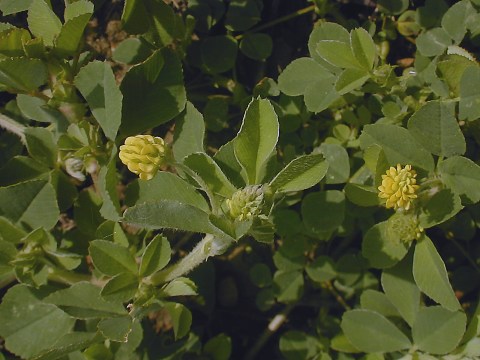Description: This plant is a winter or summer annual with prostrate or ascending stems up to 2½' long. These stems are light green or reddish green and densely covered with white hairs (although older stems become less hairy); they branch occasionally. The alternate compound leaves are trifoliate. Young trifoliate leaves toward the tips of the stems have short hairy petioles, while older trifoliate leaves have longer petioles. At the base of each petiole, there is a pair of stipules that are lanceolate to ovate and variable in size. The leaflets of the compound leaves are up to 2/3" (17 mm.) long and about one-half as much across; they are medium to dark green, obovate or oval-ovate, hairy or nearly hairless, and slightly dentate along their margins. Each middle leaflet has a short stalk, while the lateral leaflets are sessile. The upper surface of each leaflet has fine lateral veins that are light green and straight.

Occasionally,
individual flowerheads are produced from the axils of the trifoliate
leaves on peduncles up to 3" long. Each flowerhead is about ¼" across
and globoid in shape; it consists of a dense cluster of 15-50 yellow
flowers. Each flower is about 1/8" (3 mm.) long; when fully open, it
has a
pea-like floral structure with an upper standard and lower keel; the
former is relatively larger than the latter in size. The base of each
flower consists of a small green calyx with 5 narrow teeth. The
blooming period occurs from late spring to early fall and can last
several months. Each flowerhead is replaced by a dense cluster of
seedpods. Each seedpod is dark-colored, hairy, strongly curled, and
about 1/8" (3 mm.) long; it contains a single dark seed that is
somewhat
flattened and reniform (kidney-shaped). The root system consists of a
coarse branching taproot that can form nodules.
Cultivation:
This plant thrives in areas with full to partial sun, moist to mesic
conditions, and soil containing loam, clay-loam, or gravel. It is weedy
and aggressive, but often overlooked because of its low growth habit
and relatively small size. The roots add nitrogen to the soil by
forming an association with rhizobial bacteria.

Range & Habitat:
Black Medic occurs in every county of Illinois and it is quite common.
This plant
was introduced from Eurasia into North America for agricultural
purposes. Habitats include
prairies (black soil, clay), weedy meadows, old fields, cropland,
pastures, vacant lots, landfills, cemeteries, lawns, areas along
railroads and roadsides, and miscellaneous waste areas. This plant is
usually found in highly disturbed areas, although it can invade high
quality prairies. In the latter case, it becomes one of the understory
plants that can tolerate the shade of taller prairie vegetation.
Faunal Associations:
The nectar and pollen of the flowers attract various insects,
particularly bees (Andrenid bees, honeybees, bumblebees, &
Halictid bees). Other insects sucking nectar from the flowers include
thick-headed flies (Conopidae) and small butterflies; see Müller
(1873/1883) for a discussion. The foliage is edible to mammalian
herbivores.
Photographic Location:
A lawn in Champaign-Urbana, Illinois. The flowerheads in the photograph
are still in the bud stage.
Comments:
Black Medic looks like a sprawling Trifolium sp.
(Clover) with small yellow flowerheads, however it is more closely
related to Medicago sativa (Alfalfa). This is
because their seedpods have a similar structure, although the seedpods
of Alfalfa are more coiled than those of Black Medic. Other species in
this genus include Medicago arabica (Spotted Medic)
and Medicago orbicularis (Round Medic). These
latter species are rare in Illinois and their seedpods are strongly
coiled and spiny. Generally, all of these species have been introduced
from Eurasia into North America as a source of forage for livestock or
to replenish
agricultural soil with nitrogen.